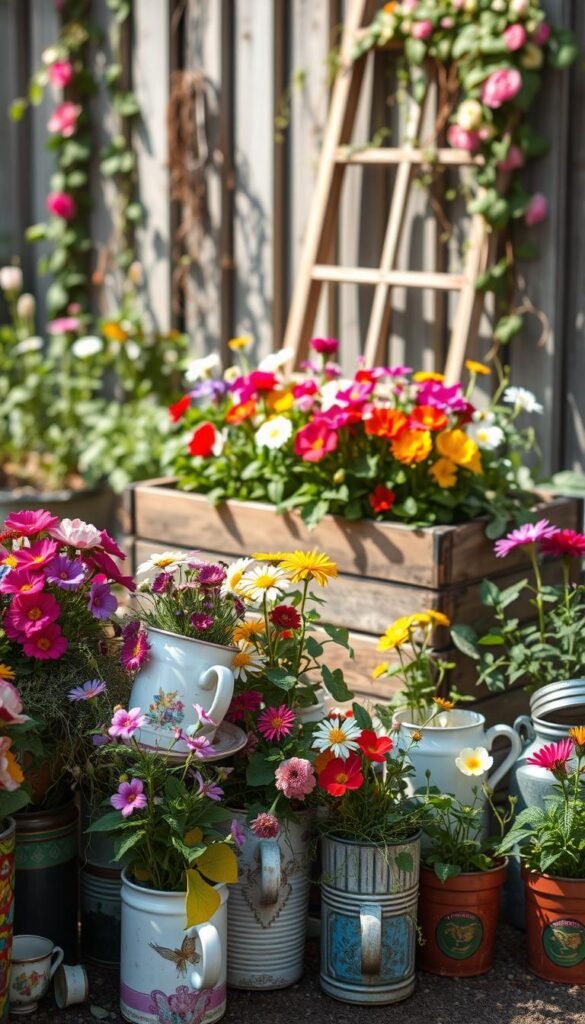What if your old coffee cans, worn-out boots, or chipped bathtubs could become the stars of your outdoor space? Transforming everyday objects into vibrant planters isn’t just a trend—it’s a smart, sustainable way to breathe new life into items that might otherwise end up in landfills. This method lets you craft a one-of-a-kind garden while saving money and reducing waste.
Imagine neighbors stopping to admire your quirky strawberry planter made from a retro colander or herbs thriving in gutters mounted along your fence. These projects aren’t just eye-catching—they’re practical. Many budget-friendly containers already have built-in drainage, like kitchen sieves or wooden crates, making them ideal for plants.
This approach taps into the growing movement of upcycling, where creativity meets environmental care. You’ll discover how simple tweaks—like adding soil to a vintage wagon or turning eggshells into seedling starters—can create stunning displays. It’s about more than looks: repurposing materials like newspaper pots or cardboard trays enriches your soil as they break down.
Best of all, these ideas let your personality shine. Whether you’re planting succulents in teacups or growing tomatoes in olive oil tins, your space becomes a reflection of your style. Ready to turn that “junk” drawer into a garden goldmine? Let’s explore how ordinary objects can grow extraordinary results.
Embrace Creative Repurposing for Your Garden
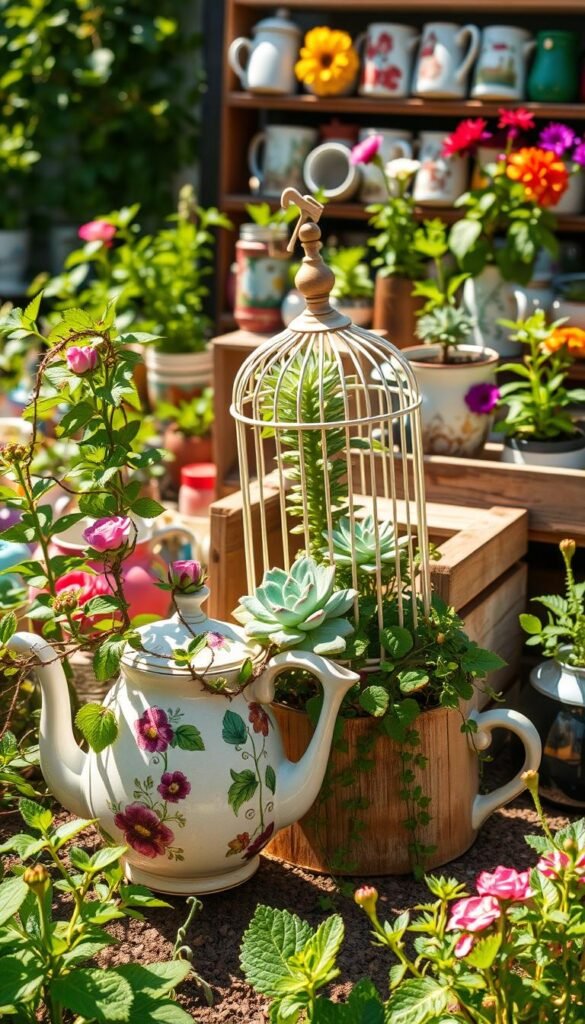
Ever wonder what that forgotten colander or chipped dresser drawer could become? Ordinary objects hold hidden potential when viewed through a creative lens. With some imagination, you can craft functional living art that sparks joy and conversation.
Discover Hidden Gems in Plain Sight
Start by assessing items based on two factors: practicality and personality. A leaky watering can becomes a whimsical herb planter, while wooden crates stack into modular vertical gardens. Consider these transformations:
| Material | Best For | Pro Tip |
|---|---|---|
| Ceramic | Succulents, small flowers | Drill drainage holes with diamond-tip bits |
| Metal | Herbs, trailing vines | Line with coconut coir to prevent rust stains |
| Wood | Vegetables, shrubs | Use food-safe sealant for edible plants |
Infuse Meaning Through Curated Objects
That powder-blue bicycle with a basket? Perfect for lavender. Grandma’s weathered boots? Ideal for memory-filled blooms. Vintage finds add layers of story to your outdoor design narrative.
Search local flea markets for:
- Ornate picture frames as trellises
- Chipped teacups as fairy garden accents
- Ladder shelves as tiered displays
“The best containers aren’t bought—they’re discovered through seeing ordinary things in extraordinary ways.”
This approach turns your space into a living scrapbook. Each piece reflects your journey, from thrifted treasures to family heirlooms. The hunt itself becomes part of the joy, blending sustainability with self-expression.
DIY Flower Garden Ideas: Creative Ways to Repurpose Household Items
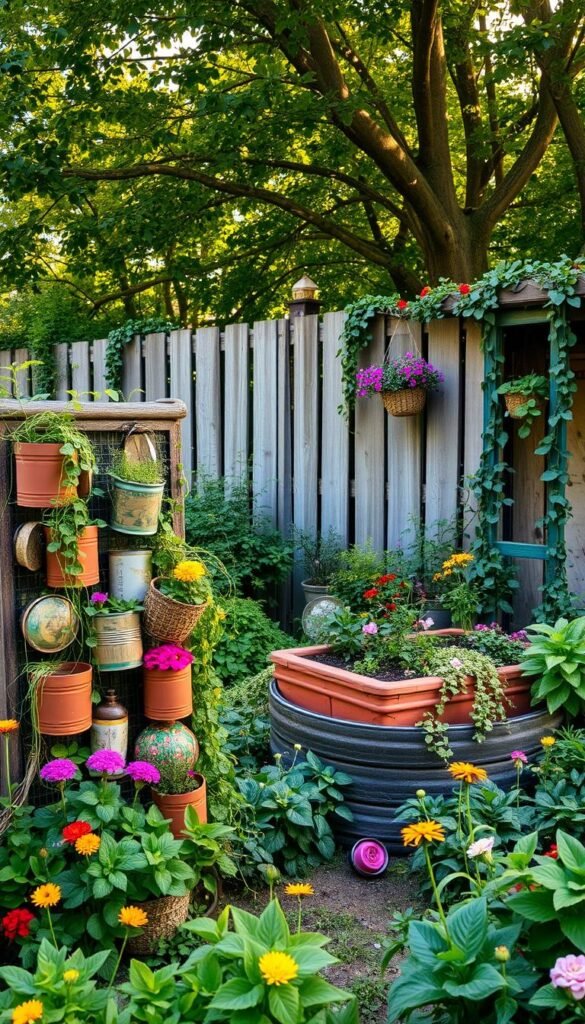
Did you know America’s landfills could fill 40,000 Olympic pools with trash? That staggering 2018 statistic shows why reimagining discarded materials matters. When you transform old objects into planters, you’re not just decorating—you’re shrinking your environmental impact while crafting a meaningful landscape.
Choosing recycled materials cuts costs dramatically. New ceramic pots often cost $15-$50, while upcycled alternatives require only creativity. Compare these options:
| Material | New Cost | Upcycled Cost |
|---|---|---|
| Planter | $12-$75 | $0 (existing items) |
| Soil additives | $8/bag | Free (compost) |
| Decor | $20+ | Repurposed finds |
Your eco-friendly garden becomes a neighborhood showstopper. A painted dresser-turned-planter or bicycle-wheel trellis sparks conversations about sustainability. These unique pieces can’t be bought—they’re born from your perspective.
Beyond aesthetics, this approach sharpens problem-solving skills. Finding drainage solutions for colanders or adapting drawers for root depth turns gardening into a puzzle. Each success builds confidence to tackle bigger projects.
“Sustainability isn’t about perfection—it’s about progress. Every repurposed item is a step toward healthier ecosystems.”
You’ll feel pride watching seedlings thrive in what was once considered junk. This method transforms your space into a living testament to resourcefulness, proving beauty and environmental care can grow side by side.
Innovative Planters and Containers From Everyday Objects
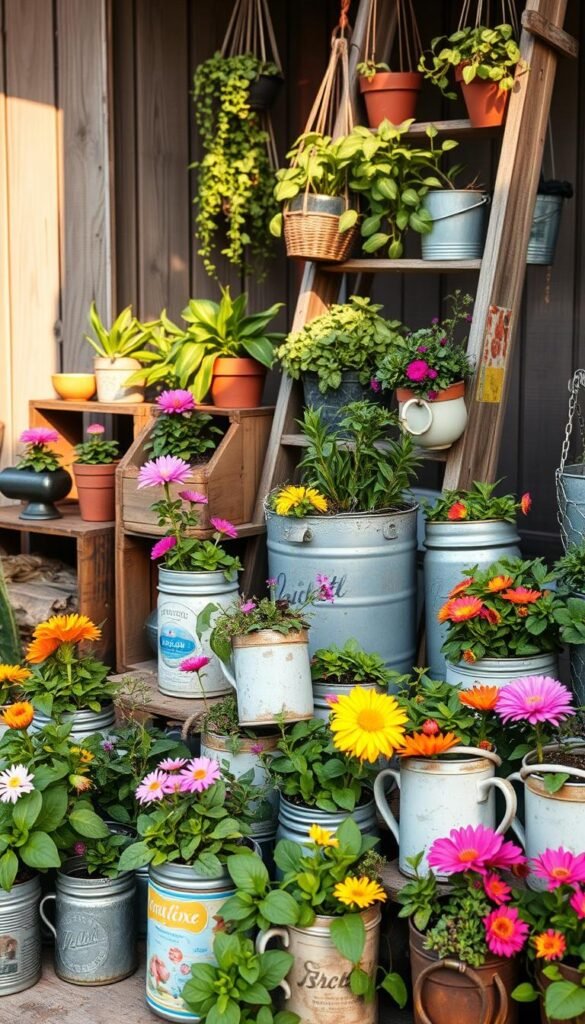
Your kitchen junk drawer might hold the secret to your next stunning planter. With a few simple tweaks, everyday objects become functional homes for greenery that add character to any space. Let’s explore how to match materials with plants while solving practical challenges like drainage and durability.
Upcycling Tin Cans, Tea Cups, and Mugs
Empty tin cans shine as budget-friendly plant pots. Remove labels with warm soapy water, then sand sharp edges. Drill two holes in the bottom using a 1/4″ bit—this prevents soggy soil while letting excess water escape. Paint exteriors with outdoor-grade spray paint for weather resistance.
Delicate teacups work best for small succulents. Their shallow roots thrive in limited space, and the porcelain retains moisture without drowning plants. Cluster mismatched mugs on windowsills for a playful herb garden—basil and thyme love these cozy spaces.
Breathing New Life Into Old Furniture and Bins
That cracked dresser gathering dust? Remove drawers and line them with landscape fabric. Fill each compartment with potting mix for a cascading flower display. Wooden pallets transform into vertical gardens when stood upright—stuff gaps with moss and fill soil for strawberries or trailing vines.
Check structural integrity first: reinforce wobbly legs on tables-turned-planter stands. Metal bins need rust treatment before hosting plants. Always add drainage—drill holes or layer gravel beneath soil to protect roots from rot.
Step-by-Step Projects to Transform Your Backyard
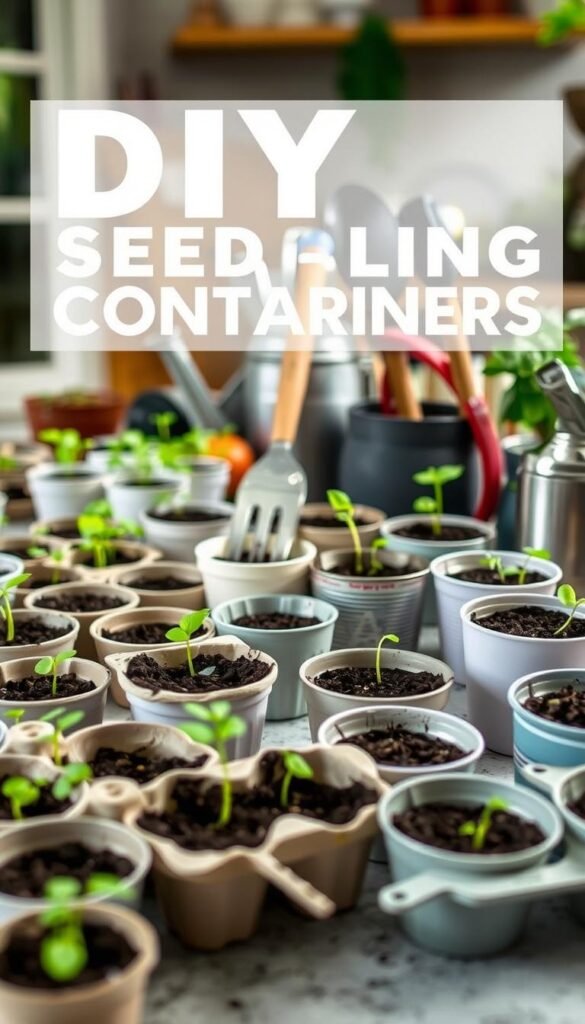
Ready to turn spare containers into thriving green spaces? These hands-on projects combine practicality with imagination, letting you grow healthier plants while reducing waste. Let’s dive into methods that turn ordinary objects into functional growing systems.
From Seedling Containers to Mini Greenhouses
Start small with egg cartons or toilet paper tubes. Poke two drainage holes in each section using a thumbtack. Fill with potting mix and seeds—these biodegradable options let you transplant seedlings directly into your garden later.
| Material | Best Use | Prep Steps |
|---|---|---|
| Plastic Bottles | Mini Greenhouses | Cut bottom third, remove cap |
| Paper Cups | Seed Starters | Add holes, label varieties |
| Wooden Pallets | Compost Bins | Secure sides with wire |
Managing Drainage and Moisture for Healthy Plants
Plastic cookie containers become self-watering systems. Drill three 1/8-inch holes near the base, then layer pebbles beneath soil. This setup prevents root rot in herbs like basil or mint.
For larger planters made from furniture or bins, line interiors with landscape fabric. It allows airflow while keeping soil intact. Coffee grounds mixed into potting mix help acid-loving varieties thrive—just 1/4 cup per container works wonders.
Want more budget hacks? Explore these clever solutions for arranging containers that save space and resources. Your backyard will buzz with life—and sustainability—in no time!
Incorporate Eco-Friendly and Sustainable Gardening Techniques
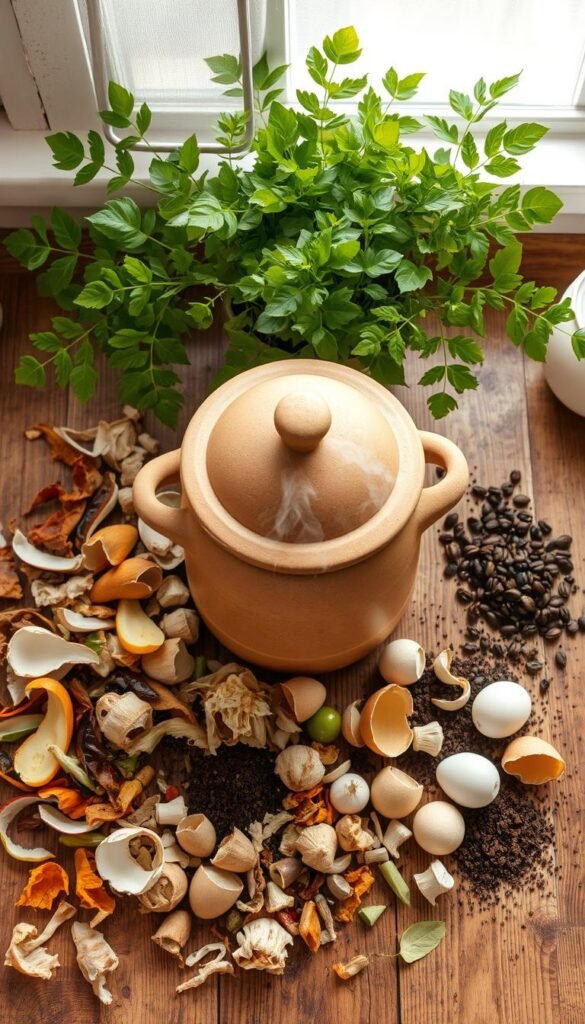
Did you know your morning coffee could do more than wake you up? Those used grounds become powerful allies in your eco-friendly garden, nourishing plants while keeping kitchen scraps out of landfills. Let’s explore how everyday leftovers can fuel your green space.
Smart Scrap Management for Healthier Plants
Start by separating compost-friendly items. Coffee grounds work wonders for acid-loving plants like hydrangeas and blueberries—mix them directly into soil or add to your compost bin. Crushed eggshells offer calcium for tomatoes and peppers while deterring slugs naturally.
Create a simple composting system using repurposed bins or buckets. Layer materials like this:
| Add These | Avoid These |
|---|---|
| Fruit peels | Meat products |
| Tea bags | Dairy items |
| Dry leaves | Pet waste |
Turn your pile weekly to speed decomposition. Proper moisture levels feel like a wrung-out sponge—add dry leaves if too wet, or spray water if dry. In 2-3 months, you’ll have rich compost ready for container gardens or flower beds.
“Composting turns ‘waste’ into black gold—it’s the ultimate recycling program for your backyard.”
Stuck with citrus peels or onion skins? Bury them near shrubs instead of composting—their strong scents repel pests. This approach cuts household waste while giving your plants free nutrients. Watch your garden thrive as you close the loop between kitchen and soil!
Final Reflections on Your Garden Makeover Journey
Your garden becomes more than plants in pots—it’s a living canvas where imagination meets sustainability. By rethinking ordinary items, you’ve crafted a landscape that tells your story. Each repurposed container, from painted tins to vintage drawers, adds character while keeping materials out of landfills.
This approach blends practicality with artistry. A colorful colander bursting with petunias or herbs in stacked crates proves that great design doesn’t require big budgets. These touches create visual interest and spark conversations about eco-conscious living.
Looking ahead, your space will evolve as you discover new ways to merge function and beauty. Need inspiration? Explore budget-friendly strategies for arranging pots or enhancing soil health. Every choice—like using compost or rainwater—strengthens your garden’s environmental impact.
Celebrate how far you’ve come. What began as simple upcycling projects now forms a vibrant ecosystem. Your gardens reflect resourcefulness, proving that creativity grows best when rooted in purpose.

